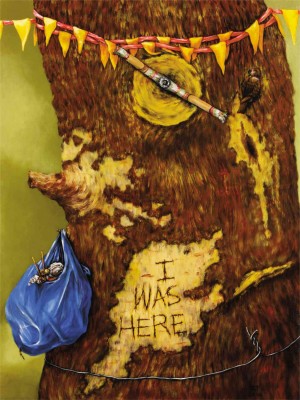
MANILA, Philippines—Woodlands are given visual voice in “If Trees Could Talk,” an exhibit championing the environment organized by the Center for Art, New Ventures and Sustainable Development (Canvas).
Canvas once again partners with Globe Telecoms (they collaborated in TEDx Diliman, an exhibit of art on tarpaulin later recycled as bags). The new works were initially unveiled at the Globe Center in Taguig. Globe is involved in reforestation projects in Maguindanao and the Cordillera.
“The exhibit is not just about the environment, it marries art, environment and also our campaign for children’s literacy,” said Canvas executive director Gigo Alampay. “The paintings will be part of a book that we’re publishing. We’re actually commissioning essays and short stories, and they will be put together as a full-color children’s book, thousands of which will be given away to kids all over the Philippines.”
Alampay explained the exhibit and publication would be part of “our campaign to get children not just to learn to read, but also to learn to love books; and we think that learning to love books and reading becomes a lifelong skill that they can use to lead productive lives.”
Key step
Reading books aloud is a key step in the process of learning and may perhaps be equated to the verbal nurturing that is said to keep foliage growing healthy. Talking to plants apparently helps them grow and be well. So, the pertinent question in this time of massive tree-felling would indeed be, “What if they could talk back?”
Tammy Tan’s scarred tree is saying, “I was here,” as carved by a vandal on its trunk strung with streamers and wounded by a spinning firecracker. All that’s left of the once-proud tree are “Remnants,” as the painting is titled.
Alee Garibay’s haunting painting seems to take its inspiration from Greek mythology, as its figure seems like an evocation of Pan, the god of mountain wilds.
Poster boys and girls for the environmental cause are the subjects of Elmer Borlongan’s fervent “Tree Huggers.”
Leonard Aguinaldo’s “Minding the Trees” makes use of the artist’s trademark ukir or hand-colored rubber to rouse everyone’s ecological consciousness.
Trash threat
Colorful loom bands are used by Ruel Caasi to mimic trees in his mixed-media piece. The little stretchable plastic rounds, a current craze, have been made into jewelry and even articles of clothing. They are, however, a huge non-biodegradable trash threat, and Caasi is spot-on as he cleverly shows how synthetics has undermined the environment.
A poke, too, at logging is Anton del Castillo’s “Ibalik Mo Ako sa Tunay Kong Anyo.” Seen here is an ornately carved chair, set against a backdrop of red with gold to signify grandeur. The painting seems to say that logging for exquisite wood furniture may be untenable and unsustainable.
Nature being overcome by technological refuse is rendered in Ninel Constantino’s bleak gray landscape marked by a skeletal tree, which perhaps shows that if we ever do talk to plants and listen to what the trees have to say, it will merely become, as the title says, “A Forgotten Conversation.”
“If Trees Could Talk” is on view in Canvas Gallery and Garden at 1 Upsilon Drive Ext., and Zuzuaregui Street, Alpha Village, Diliman, Quezon City. For more information, e-mail info@canvas.ph or text/call 0917-3064175.